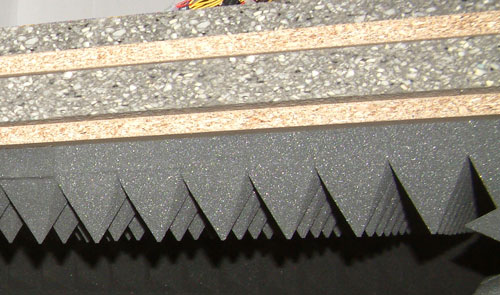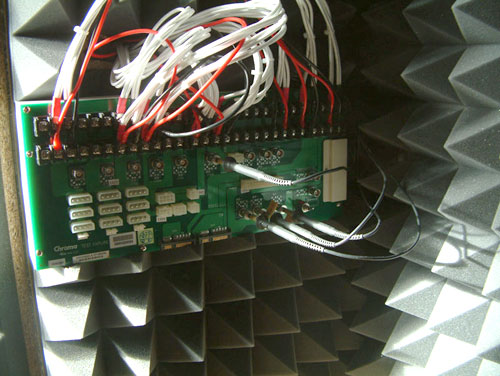FSP Epsilon 80Plus 600W
by Christoph Katzer on August 5, 2008 8:00 PM EST- Posted in
- Cases/Cooling/PSUs
Testing with the Chroma ATE Programmable Load

Our test equipment consists of two Chroma programmable DC Loads that enable us to test power supplies with an output of up to 1500W. The biggest advantage of the Chroma DC Loads is simply the high precision it provides. It can measure differences as small as 0.001V and 0.0001A, which will provide us with best-in-class results.
When programming the Chroma with specific amounts of load calculated according to the ATX norm, we are able to load power supplies to an exact percentage. We can now show results at every specific percentage needed. To get the best overview of a power supply, we load each unit with 10%, 20%, 50%, 80%, 100%, and 110% of the specified output. This is easy to calculate for a 1000W power supply: the 10% load is 100W and 110% load is 1100W. Remember that this is the amount of power the PSU delivers; due to inefficiencies, a power supply will actually draw more power from the wall.
Note: If you would like to know more about our testing methodology, equipment, and environment, please read our PSU testing overview.
We have added an additional 10% on the highest load to see how the units perform with overload. This test will be performed in all future reviews. The overload test is performed at room temperature as well as under more stressful conditions; to ensure we are not too cruel to the power supplies, we will keep the ambient temperature at 50°C in the stress test. Experience shows that many units can stand the overload at room temperature but will experience problems with higher temperature and overload together. Only the best-built units will survive this.

The Testing Environment
There is one flaw in testing power supplies with programmable loads while trying to measure the sound pressure levels at the same time. Because the programmable loads get very loud, there is no chance of hearing the power supply on the test stand. In order to make accurate measurements of the noise levels we needed a way to separate the test unit and the programmable loads. Our solution was to build a very thick box around the unit.

We concluded that a five-layer box with a total thickness of 6" (15cm) containing two layers of wood and three layers of special foam would suffice. It is designed as a box within a box. The inner box does not touch any part of the outer box, making it difficult for acoustic noise to pass through in the form of vibration. Each box is isolated on both sides with a layer of heavy foam that is normally used to insulate engines. On the inside we have an additional layer of 4" (10cm) thick pyramidal foam on every side of the box to eliminate the acoustic waves coming from the test object as well as we can.

To ensure a completely closed system we installed the printed circuit board that the connectors of the power supply are attached to inside the anechoic room/box. In other box designs, you would need to put all the cables through the wall. Unfortunately, that would result in the inside of the box not being fully isolated anymore. Our design keeps everything that needs to be connected inside of the box and maintains isolation.










19 Comments
View All Comments
Amart - Wednesday, August 6, 2008 - link
-1FSP Epsilon above 500W are known to have Ripple/Noise problems, and the "spec" for maximum is much higher then anyone would want to buy.
Capacitors age, and Ripple/Noise increases over the lifetime of this product - so starting out very-low is a requirement for a quality unit. I've seen plenty of tests of $80+ units that failed to provide the quality they promised.
C'DaleRider - Wednesday, August 6, 2008 - link
Fucktard? My, my, little boy games calling names....makes you such a big boy, doesn't it?I guess despite the education proper testing sites have attempted to do in testing power supplies has eluded you. Ripple and noise is quite important...but since you care not for ever seeing the values presented, and it's not hard to get them, AT's vaunted Chroma gives them so why cannot they be presented is beyond me.
And to show the ripple/noise graphing is very simple, too. An oscilloscope is all that's needed....and if a website can afford a Chroma, it certainly can afford an oscilloscope.
Without proper presentation of ripple/noise generation at given output levels, their testing is incomplete. To be within spec is rather meaningless as 115mV of ripple on the +12V rail at full rated output is within spec, but I wouldn't buy a power supply that produced that much ripple/noise.
Come on AT, get with the program and show us complete information, or is HardOCP, Hardware Secrets, and JonnyGuru's sites the only ones that will do proper testing and leave you as an also-ran testing site.
strikeback03 - Wednesday, August 6, 2008 - link
If you don't trust them to say "Ripple Results are fine" then why would you trust a graphic? Never heard of Photoshop? Or use Labview to generate a signal to be read by an oscilloscope? If a reviewer actually wants to deceive, a picture isn't any harder.JarredWalton - Wednesday, August 6, 2008 - link
That's pretty much my thoughts as well. Christoph did include ripple tests and charts in some previous articles (http://www.anandtech.com/casecoolingpsus/showdoc.a...">for example, this roundup), but didn't feel like the amount of time required to generate all the charts really added anything to the results. Given that he HAS done those tests in the past, I see no reason to think that he's not conducting those tests now. That he condenses a bunch of charts that take a significant amount of effort to create into a short statement on ripple doesn't really bother me at all. Though I do have to say, at least reporting the mV ripple values as he's done in the past would be good.Amart - Thursday, August 7, 2008 - link
He does NOT condense. If he wanted to condense he would give the average number he's getting from the calculation.Simply saying that something is "within spec" is unacceptable in a professional review, for reasons outlined in the above replies.
He must show the numbers, whether in a graph or simply writing them down. It won't take more space or time - if he's actually doing the testing.
JarredWalton - Thursday, August 7, 2008 - link
Usually Christoph has listed the ripple values. I'm not sure why he didn't put them in this article. Compare to the last article, where he mentions 8mV or whatever. I'll flog him and make sure we get some numbers for future PSUs. :)Amart - Friday, August 8, 2008 - link
Why not for this one? This isn't paper print, you can edit.Both methodology and results for such key testing should be posted or linked within the article - just like on other sites.
HOOfan 1 - Thursday, August 7, 2008 - link
I personally would rather see specific values for ripple rather than oscilloscope shots. By the same measure, I would rather see specific values for voltage regulation, rather than line graph. I would rather see specific AC input versus DC output numbers instead of a line graph for efficiency. All of these should be simple and quick to whip up into a chart. As for the FSP Epsilon, for most in North America where the superior Corsair CWT and Seasonic designs can be had for the same price or even less money, I say going with the superior designs of CWT and Seasonic is a no brainer. Same for the new BFG LS line that has popped up...they need to drop the price by about $15-$20 before they can even hope to compete with the value that Corsair is putting out there.larson0699 - Wednesday, August 6, 2008 - link
I'll take their word for it....especially having already concluded that this is a good unit but still nothing on Seasonic's S12II/M12II line. Their testing is sufficient to validate that.
You can say what you want about AT, but it's their game and I think they're damn good at it, and ooh look at the pretty colors *drool*. You may find yourself more comfortable reading , Hot, Tom's, I don't care, but that's _your_ preference and one I can respect, at least moreso than "boo fuckity hoo your testing is incomplete OMGWTFBBQ". I'll tell you what'll really get results: Buy the unit, suppress the mouth.
I said good day.